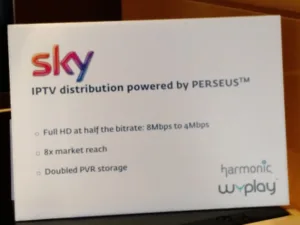V-Nova burst on the scene two years ago with a new encoding method called Perseus (Perseus Lowers UltraHD Bandwidth Requirements). Many were skeptical as the company was not the most forthcoming on how it worked. At NAB 2017, they V-Nova’s highlighted Perseus Version 2 (V-Nova Updates its Codec to V2) – and in our meetings, we finally understood what they are doing.
V-Nova has said that Perseus is not a pre-processor and that it works with other established VP-9, HEVC or H.264 encoding from other companies. So how can this be? Perseus works in parallel with the encoder. The idea is to start with a low resolution, highly compressed version of the image and run that profile through the encoder. Then, via an analysis of the image, it creates an image or data that can be run through the encoder in parallel. These higher level layers are combined into a single stream. In this way, a low resolution image will almost always be available to the end user.
New with Version 2 are additional features that provide more intelligent bit control and a temporal element to the enhancement layer. Version 1 had no GOP structure, but version 2 adds some look ahead and look behind capability. Perseus 2 is also more efficient and it adds VP-9 and HEVC support. In version 1, the base layer was always one-quarter resolution. In version 2, this resolution can be varied. It also has added better ways to detect and compress edges, textures, faces and other psycho-visual elements that add fidelity to the image.
The company also noted that they recent purchased IP from Faroudja that is a pre-processor technology. This is not in version 2 but may show up in version 3.
V-Nova says that with Perseus 2, they can offer more than 50% improvement in compression efficiency vs. their competitors. It includes lighter HTML5 video decoding requirements and lower decoding power requirements.
Partners already using the new version include FastFilmz and Thaicom. The CEO of FastFilmz, Karam Malhotra, says this version will allow his company to offer better video quality over 100 kbps 2G/EDGE networks.
In their suite at NAB, they showed a number of demos on mobile and TV devices. The phone demo showed 720p content running at 95 Kbps. It did not look very good, but it is aimed at older telecom infrastructures with limited data rates (like India or Thailand) where just getting a video signal is a victory. However, UHD content at 4 Mbps looked pretty good. There was also a side-by-side of HEVC UHD content at 25 Mbps vs. Perseus 1 at 12 Mbps with comparable image quality. A Sky demo showed half the screen running with H.264 HD resolution at 8 Mbps vs. Perseus 1 at 4 Mbps. – CC

